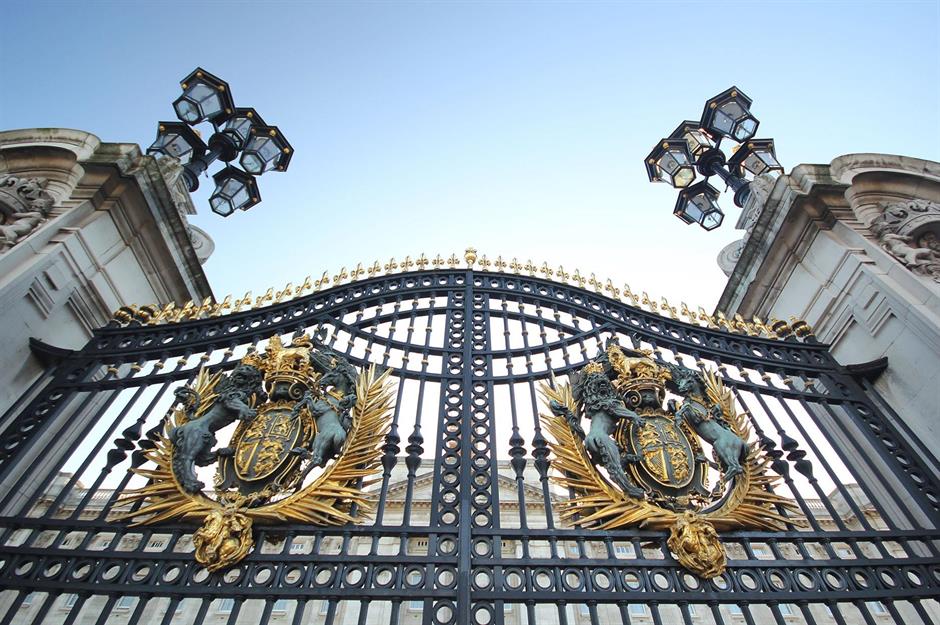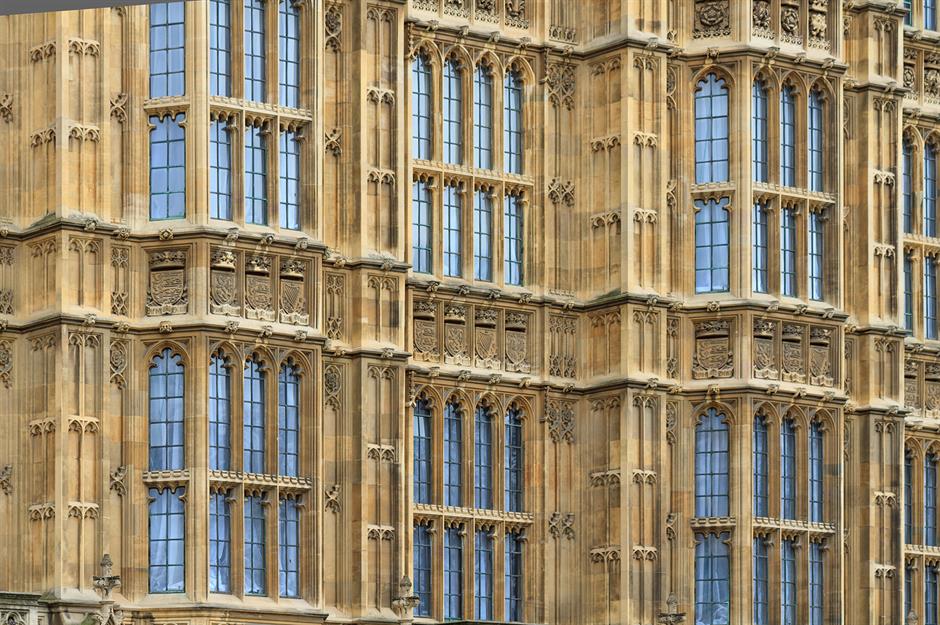Can you guess these UK landmarks from their close-ups?
The UK from a different perspective
These windows belong to…
Palace of Westminster, London, UK
Originally a royal residence in the 11th century, the Palace of Westminster in London was mostly demolished in a fire in 1834 and rebuilt as we know it later in the 19th century. Today, it’s the meeting place for both houses of parliament in the United Kingdom – the House of Lords and the House of Commons.
This masonry work is part of…
Hadrian's Wall, Cumbria, Northumberland & Tyne and Wear, England
Erected by the Romans around AD 122, the mighty stone wall was built under the orders of Emperor Hadrian to keep the ‘barbarians’ out. It once stretched nearly 73 miles (117km) from coast-to-coast in the north of England, and took three legions of men at least six years to complete. Discover little-known incredible Roman ruins around the world.
This is the view up to…
Tower Bridge, London, England
Open to both cars and pedestrians, this bridge stretches from the Tower of London to the Shad Thames on the South Bank, and its fairy-tale turrets have made it one of London's most famous structures. There’s a museum in the towers that also allows access to the Victorian engine rooms and high-level walkways that include a spine-tingling glass section. Here are 29 of the world's most beautiful bridges.
This royal emblem is found in…
Edinburgh Castle, Edinburgh, Scotland
Standing high above the historic city of Edinburgh on the volcanic plug known as Castle Rock, this mighty fortress is one of Scotland’s most visited attractions – and rightly so. The earliest surviving structure here, St Margaret's Chapel, dates to the 12th century and was built by David I, in honour of his mother, Saint Margaret of Scotland. The castle was the main Scottish Royal residence until the union of the crowns in 1603. Find out secrets of the world's most incredible castles.
You'll find this shelved arch in…
Roman Baths, Bath, England
One of the most popular Roman sites in Britain, this ancient bathing complex is slap-bang in the centre of picturesque Bath next to the beautiful medieval Bath Abbey. Built to make the most of the natural, mineral-rich thermal waters here, the magnificent Great Bath forms the centrepiece of this site, but the ruins are extensive and the museum incredibly informing. Take a look at the world's most incredible Roman ruins you have to see to believe.
These striking windows are from…
Royal Pavilion, Brighton, England
This is the top of…
Spinnaker Tower, Portsmouth, England
Visible from about 23 miles (37km) away, the Spinnaker Tower is the most recognisable feature at Portsmouth's historic harbour. Various delays meant it didn’t open until 2005, but the striking structure has been a hugely popular attraction ever since. The design, which suggests sails billowing in the wind, might look like it belongs in Dubai, but the vertiginous Sky Deck offers views of the Solent and beyond.
This door belongs to…
Caernarfon Castle, Caernarfon, Wales
Though the country has plenty of landmark castles, Caernarfon Castle, in the historic town Caernarfon, is often cited as one of Wales’ most impressive and has UNESCO World Heritage Site status. Built under the orders of Edward I in the 1200s, the castle was used for the investiture of the Prince of Wales in 1911 and again in 1969. Discover 30 of Britain's most historic towns and cities.
These columns adorn…
This stunning landmark was built by the architect James Gibbs between 1737 and 1749 to house a new scientific library. It's probably the city's most notable landmark and has provided inspiration to several authors, including JRR Tolkien and Philip Pullman, and is featured in several TV series and films, including 2007's The Golden Compass, based on Pullman's novel.
The Radcliffe Camera, Oxford, England
Oxford is stuffed with historic buildings, but the striking circular dome of the Radcliffe Camera is arguably the city's most distinctive sight. The Latin word 'camera' means 'chamber', and the building was also named after the royal physician Dr John Radcliffe, who bequeathed funds to Oxford University. Today, it's the main reading room of the Bodleian Library. Take a look at the world's most incredible libraries.
This is the façade of…
Coventry Cathedral, Coventry, England
Coventry Cathedral is a striking modernist structure, rising above the ruined shell of the old one that was destroyed in the Coventry Blitz. The city suffered huge losses on 14 November 1940, when 1,200 people were killed and hundreds of its medieval buildings destroyed. The haunting words “Father forgive” are etched above the altar of the ruined medieval church, which remains hallowed ground.
You'll find this on the side of…
Angel of the North, Gateshead, England
Looming over the A1 on the mound of an abandoned coal mine in Gateshead, Antony Gormley’s extraordinary and once controversial piece of public art has become a cherished landmark in England’s northeast. The wingspan of the colossal steel masterpiece is nearly as wide as a jumbo jet at 177-feet (54m) across and the statue stands 66-feet (20m) tall. Here are 50 defining British landmarks.
This metalwork is part of…
Forth Bridge, Edinburgh and Fife, Scotland
This is the façade of…
V&A Dundee, Dundee, Scotland
In September 2018, Scotland's fourth-largest city emerged as a must-visit arts and design destination when the V&A Museum of Design, the first V&A outside of London, opened its doors. Dundee had also already been named as the UK’s first UNESCO City of Design (nominated for its diverse contributions to fields including medical research, comics and video games). Marvel at the world's most beautiful museums.
These rocks are part of…
Giant's Causeway, County Antrim, Northern Ireland
As its name suggests, this geological wonder in Northern Ireland is linked to the legend of two giants: Irish Finn McCool and his archenemy, the fearsome Scottish Benandonner. The story goes that McCool was determined to defeat his enemy once and for all, so he broke off great hunks of the Antrim coast and arranged them in the sea to make a pathway to Benandonner. Now take a look at fantastic travel photos that will make you feel better about the world.
This is the roof of…
Eden Project, Cornwall, England
A vast garden and eco attraction built in an old Cornish clay pit, the Eden Project’s striking geodesic domes have become a world-famous site in Cornwall. The biomes are filled with thousands of different species of plants and trees – its enormous Rainforest Biome is almost twice as tall as the Tower of London. Now check out the jaw-dropping, unexplored places you can only see in photos.
The bow of this ship belongs to…
Royal Yacht Britannia, Leith, Scotland
During her 44-year career, Britannia travelled 1,087,623 nautical miles, calling at more than 600 ports in 135 countries, taking members of the royal family across the globe on trips including official tours and honeymoons. Britannia was the last of 83 different British Royal Yachts owned by the monarchy, with Queen so fond of the ship, she shed a tear at the decommissioning ceremony. Take a closer look at the historic vessel here.
This letterbox belongs to…
10 Downing Street, London
This lump of stone belongs to…
Stonehenge, Wiltshire, England
It’s still something of a mystery as to why and how the famous monument of Stonehenge was erected, although its alignment to the midsummer sunrise and midwinter sunset can’t be a coincidence. The circle of stones was probably erected in around 2500 BC although there is evidence of activity in the area dating from 8500 to 7000 BC. The 13-feet (3.9m) high, 25-tonne stones are remarkable as they would have been extremely difficult to arrange without modern tools and practices. Take a look at stunning images of the world's historic attractions in 2019.
This magnificent ceiling belongs to…
York Minster, York, England
You’ll find this ceiling in the Chapter House of York Minster, a Gothic cathedral whose magnificent towers rise high above the historic city. Officially called the Cathedral and Metropolitical Church of Saint Peter in York, it’s the seat of the Archbishop of York, the third-highest office of the Church of England. The cathedral is also notable for having the largest expanse of medieval stained glass in the country. Now discover the world's most beautiful cathedrals.
These gates belong to…
Buckingham Palace, London
The Queen’s main residence, Buckingham Palace has not always looked quite so grand as it does today. It began life as Buckingham House, a sizeable town house constructed in 1703 for the Duke of Buckingham. It wasn't until the late 1820s that it would become a palace: George IV, who acquired the house from his father, set about making it a lavish abode fit for royalty. The palace has some 775 rooms, with 240 bedrooms (including royal, guest and staff sleeping quarters), 78 bathrooms and 19 staterooms. Peek inside some of the world's most enchanting stately homes.

